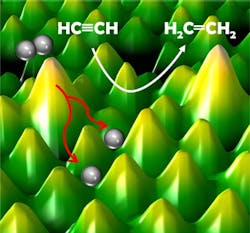Single Atom Alloys Enhance Catalysis
By scattering single atoms of palladium onto a copper base, a team of researchers from Tufts University's School of Arts and Sciences and School of Engineering, Medford, Mass., say they have developed low-cost and environmentally friendly hydrogenation catalysts that may be useful for producing agricultural chemicals, pharmaceuticals and other fine chemicals. The model catalysts boast higher selectivitities than conventional ones, notes Charles Sykes, an associate professor of chemistry in the School of Arts and Sciences who led the project.
The researchers heated small amounts of palladium to almost 1,000° C (1,830° F). As the metal evaporated, it released single palladium atoms that embedded themselves onto a copper metal surface to create what the researchers term a single atom alloy.
Research shows the single metal alloy is reportedly far more effective in catalyzing hydrogenation than denser mixtures of palladium and copper. Compared to layered materials, single atom alloys use smaller amounts of precious metal and may be more stable when segregating the active element into other layers. Results also indicate that the single atom approach is less susceptible to poisoning. "For example, in terms of carbon poisoning the presence of the single atom of palladium is not sufficient to decompose hydrocarbons; hence, the catalyst surface remains unchanged during the reaction," says Sykes.
"For some hydrogenation reactions, our results indicate that single atom alloys may in fact work at similar or even lower reaction temperatures than those used in industry," he adds.
"At the moment, single atom alloys seem to be effective catalysts at moderate temperatures. We believe that selective hydrogenations based on single atom alloys may offer in the future a far more atom economical and environmentally benign tool than existing methods as we achieve excellent reaction selectivities," adds Sykes.
The team used a scanning tunneling microscope to verify the catalyst. "Our scanning tunneling microscopy capabilities allow us to take a very different look at industrial chemical processes on metal alloy catalyst surfaces. The trick to our single atom alloy discovery was that we could 'see' the arrangement of atoms that was best at performing the chemical catalysis. Some industrial catalysts may in fact work this way already, however, it isn't possible to know the microscopic arrangement of atoms in these catalysts that make them work so well. Our approach allows us to figure these issues out in the lab and then start designing and testing real catalysts with the same ideal compositions," notes Sykes.
More details can be found in a recent article in Science.
Work is underway to develop hydrogenation catalysts using metals other than palladium and copper. Sykes is collaborating with Maria Flytzani-Stephanopoulos, a professor in the department of Chemical and Biological Engineering at Tufts, on the project and hopes to report new results in six months.
"We are currently investigating the synthesis and reactivity of model catalysts in ultra-high vacuum to address the stability of higher doping levels of palladium in copper substrates." Sykes notes the key challenge right now is to generate stable dispersed catalysts with appreciable lifetime on oxide and other relative supports.
"Our aim is to study and apply our single atom alloy principle in other industrially important reactions such as selective oxidations and dehydrogenations. Our ultimate goal is to design environmentally benign alternatives to existing methods for a range of industrially relevant reactions," he explains.
The next step is to design dispersed single atom alloy catalyst for testing under real conditions. Research is still in the early stages, and while it's too soon to determine when pilot-scale trials might begin, Sykes believes making the catalyst on a large scale is possible. "Once the method for preparing a dispersed single atom alloy catalyst is established, then the next step will be scale up, which is always a very important factor in the catalysis industry," he says.

